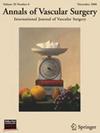血管内进展时代复杂主动脉-髂闭塞性疾病开放手术修复的远期疗效
IF 1.4
4区 医学
Q3 PERIPHERAL VASCULAR DISEASE
引用次数: 0
摘要
目的:主动脉髂闭塞性疾病(AIOD)可导致严重肢体缺血,需要血运重建。对于复杂的C型和D型病变,尽管有血管内修复的选择,开放修复仍然是首选。本研究评估了急性和慢性AIOD的开放性手术修复的长期结果。方法:对2010年1月至2020年12月接受开放式AIOD修复的患者进行单中心回顾性分析。主要结局包括30天死亡率和长期死亡率;次要结果为移植物通畅、卢瑟福分类改善和肢体保留。结果:76例患者(男性61%;平均年龄62±10岁)行TASCⅱ型D型AIOD开腹修复术。外周动脉疾病和既往干预是常见的(67例,88%)。49例(64%)患者接受了择期手术,27例(36%)患者接受了紧急手术。选择性病例的30天死亡率为0%(0/49),而紧急病例的30天死亡率为19%(5/27)。结论:开放性修复复杂AIOD的结果持久,选择性病例死亡率低,肢体保留率和移植物通畅率高。未来的研究应该探索长期的比较结果。本文章由计算机程序翻译,如有差异,请以英文原文为准。
Long-Term Outcomes of Open Surgical Repair for Complex Aortoiliac Occlusive Disease in the Age of Endovascular Advancements
Background
Aortoiliac occlusive disease (AIOD) may lead to critical limb ischemia, requiring revascularization. Open repair remains preferred for complex type C and D lesions despite endovascular options. This study evaluated long-term outcomes of open surgical repair in acute and chronic AIOD.
Methods
A single-centre, retrospective analysis was conducted on patients undergoing open AIOD repair (January 2010-December 2020). Primary outcomes included 30-day and long-term mortality; secondary outcomes were graft patency, Rutherford classification improvement, and limb salvage.
Results
Seventy-six patients (61% male; mean age 62 ± 10 years) underwent open repair for Trans-Atlantic Inter-Society Consensus (TASC) II type D AIOD. Peripheral arterial disease and prior interventions were common (67 patients, 88%). Elective surgery was performed in 49 patients (64%), while 27 patients (36%) underwent urgent procedures. The 30-day mortality rate was 0% (0/49) for elective cases but 19% (5/27) for urgent cases (P < 0.01). Long-term survival rates at 1, 2, 3, and 5 years were 98% (48/49), 96% (47/49), 94% (46/49), and 86% (42/49) for elective cases versus 78% (21/27), 62% (17/27), 62% (17/27), and 62% (17/27) for urgent cases (P = 0.30), respectively. Elective cases demonstrated high graft patency at 1, 2, 3, and 5 years (96% [47/49], 90% [44/49], 90% [44/49], and 85% [42/49]), respectively. Rutherford classification improved significantly (median preoperative stage 3 to postoperative stage 0, P < 0.001), with stable ankle-brachial index (ABI) values (≥0.9) in 59 of 61 patients (97%). Vascular complications occurred in 39 patients (51%), with reinterventions in 12 patients (16%). Sustained limb salvage was observed over long-term follow-up (median 59 months).
Conclusion
Open repair for complex AIOD offers durable outcomes, with low elective case mortality and high limb salvage and graft patency. Future studies should explore long-term comparative outcomes.
求助全文
通过发布文献求助,成功后即可免费获取论文全文。
去求助
来源期刊
CiteScore
3.00
自引率
13.30%
发文量
603
审稿时长
50 days
期刊介绍:
Annals of Vascular Surgery, published eight times a year, invites original manuscripts reporting clinical and experimental work in vascular surgery for peer review. Articles may be submitted for the following sections of the journal:
Clinical Research (reports of clinical series, new drug or medical device trials)
Basic Science Research (new investigations, experimental work)
Case Reports (reports on a limited series of patients)
General Reviews (scholarly review of the existing literature on a relevant topic)
Developments in Endovascular and Endoscopic Surgery
Selected Techniques (technical maneuvers)
Historical Notes (interesting vignettes from the early days of vascular surgery)
Editorials/Correspondence

 求助内容:
求助内容: 应助结果提醒方式:
应助结果提醒方式:


